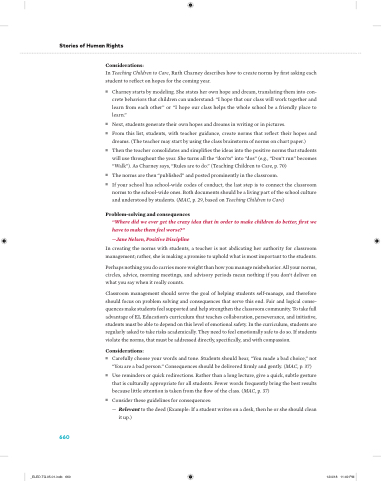Page 684 - EL Grade 5 Teacher Guide
P. 684
Stories of Human Rights
Considerations:
In Teaching Children to Care, Ruth Charney describes how to create norms by rst asking each student to re ect on hopes for the coming year.
■ Charney starts by modeling. She states her own hope and dream, translating them into con- crete behaviors that children can understand: “I hope that our class will work together and learn from each other” or “I hope our class helps the whole school be a friendly place to learn.”
■ Next, students generate their own hopes and dreams in writing or in pictures.
■ From this list, students, with teacher guidance, create norms that re ect their hopes and
dreams. (The teacher may start by using the class brainstorm of norms on chart paper.)
■ Then the teacher consolidates and simpli es the ideas into the positive norms that students will use throughout the year. She turns all the “don’ts” into “dos” (e.g., “Don’t run” becomes “Walk”). As Charney says, “Rules are to do.” (Teaching Children to Care, p. 70)
■ The norms are then “published” and posted prominently in the classroom.
■ If your school has school-wide codes of conduct, the last step is to connect the classroom norms to the school-wide ones. Both documents should be a living part of the school culture and understood by students. (MAC, p. 29, based on Teaching Children to Care)
Problem-solving and consequences
“Where did we ever get the crazy idea that in order to make children do better, rst we have to make them feel worse?”
—Jane Nelsen, Positive Discipline
In creating the norms with students, a teacher is not abdicating her authority for classroom management; rather, she is making a promise to uphold what is most important to the students.
Perhaps nothing you do carries more weight than how you manage misbehavior. All your norms, circles, advice, morning meetings, and advisory periods mean nothing if you don’t deliver on what you say when it really counts.
Classroom management should serve the goal of helping students self-manage, and therefore should focus on problem solving and consequences that serve this end. Fair and logical conse- quences make students feel supported and help strengthen the classroom community. To take full advantage of EL Education’s curriculum that teaches collaboration, perseverance, and initiative, students must be able to depend on this level of emotional safety. In the curriculum, students are regularly asked to take risks academically. They need to feel emotionally safe to do so. If students violate the norms, that must be addressed directly, speci cally, and with compassion.
Considerations:
660
■
■
■
Carefully choose your words and tone. Students should hear, “You made a bad choice,” not “You are a bad person.” Consequences should be delivered rmly and gently. (MAC, p. 37)
Use reminders or quick redirections. Rather than a long lecture, give a quick, subtle gesture that is culturally appropriate for all students. Fewer words frequently bring the best results because little attention is taken from the ow of the class. (MAC, p. 37)
Consider these guidelines for consequences:
— Relevant to the deed (Example: If a student writes on a desk, then he or she should clean it up.)
_ELED.TG.05.01.indb 660
12/4/18 11:49 PM


